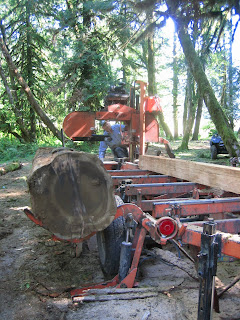A Lesson in Milling

Our summers fill farmer Greg's head with projects because this is the only time he is "off" from his non-farm job. I think he originally imagined the summers as a time where he could write his book or take a break from three hard semesters in a row. He didn't count on trees falling over in the winter, blackberries growing like the prickly rose vines in Sleeping Beauty, or the list of honey-do's that stack up over time as things fall apart in the rain.
Farmer Greg's list was long this summer, but one of the more interesting and educational projects was the milling of a number of large trees that blew down last winter, taking with them other large trees. Of course it helped that neighbor Dave connected us with an old logger on the other side of the mountain who just happened to have a mobile mill. What are neighbors for in the woods if they can't help you find your local retired woodsman? The mill was set up in the new clearing down by the spring holding tank, the site of the largest windfalls and the heaviest trees to try to drag too far from where they fell.
Greg and Randy had been cutting up and moving logs into place as soon as the ground was no longer muddy. A place was cleared for the trailer to be backed in. A peeve and wire chokers were borrowed from Dave so the logs could be maneuvered more easily into position. The surprising part - the mill man, took it upon himself to teach everyone involved how to use his machine - how to check the computer screen, how to move the controls, how to cut the size intended. I ended up being the only one not to run it for no other reason than my absence doing other projects.
For four full days, the guys (and Annie for a partial day when she wasn't taking photos of the operation) loaded large, heavy logs onto the hooks of the mill and unloaded cut boards onto the trailer. There was a list of specific sizes we needed for the manure composter we were about to build next to the barn. Then there was all the rest, cut to sizes we hoped would be useful in the future: 2x6s, 2x8s, 2x10s.
The horses and sheep came down for a look, but not for long. Too much commotion, not enough grass. The days were warm but the shade in the woods saved a few souls from heat stroke, while sawdust swirled in the air and covered both men and plants alike.
How many boards do a few windfall trees make? Lots it seems. Certainly enough to build stuff and still have a garage full. Obviously we will need to build more stuff soon or the trailer will sit out in the weather from now to kingdom come and no roof to cover it as the wood cures, and cures some more.
There was one hard lesson we learned from this project. When milling wood for a specific length, say 8 feet, the logs actually need to be cut at about 8'8" because you lose length in the milling process. This meant when we needed 12 foot lengths to tie in as beams for our new composter, 11'8" just didn't make the span. The guys tried to work our wood the best they could but there are certain rules of the game. We will know for the next time.
Meantime, I have plenty of fresh cedar and fir sawdust to blanket our blueberries for the winter and even enough to scatter in the stalls from time to time. We will have to do the math and determine whether all the labor and time were worth the effort financially, especially with the falling price of lumber. But, from an aesthetic, conservation, and educational point of view I already know it was. Sometimes the value of the product is not in how much money you saved but in the knowledge that you learned and accomplished something of value.
Photos: Milling process x 4
All Rights Reserved. Copyright 2009 Scottie Jones